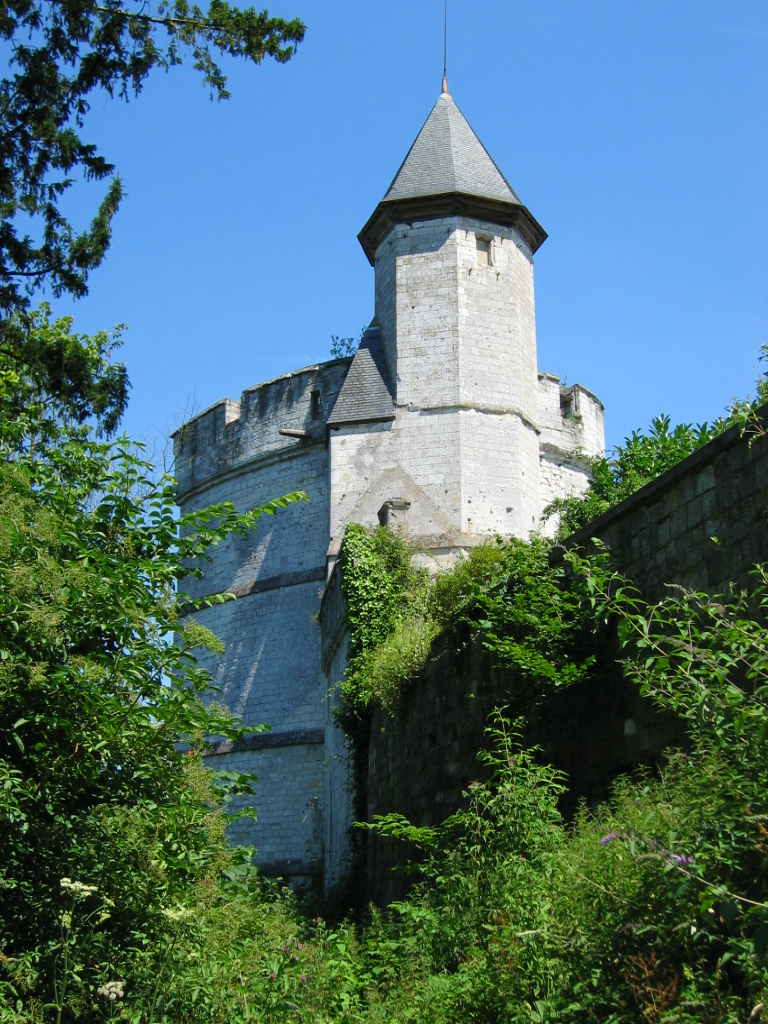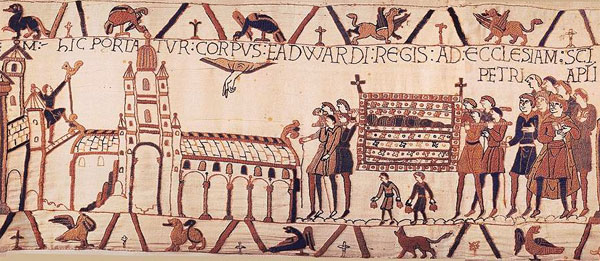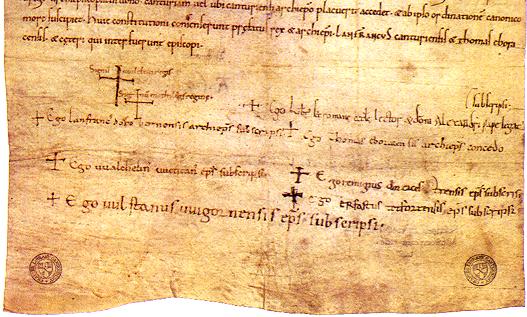|
Æthelwig
Æthelwig (–16 February in either 1077 or 1078) was an Abbot of Evesham before and during the Norman Conquest of England. Born sometime around 1010 or 1015, he was elected abbot in 1058. Known for his legal expertise, he administered estates for Ealdred, the Bishop of Worcester prior to his election as abbot. After his election, he appears to have acted as Ealdred's deputy, and was considered as a possible successor when Ealdred was elected Archbishop of York. Æthelwig worked during his abbacy to recover estates that had been lost to Evesham, as well as acquiring more estates. After the Norman Conquest, in 1066, Æthelwig was one of the few Englishmen trusted by the new King William the Conqueror, and was given authority over parts of western England. As part of his duties, he was a royal judge and held important prisoners. During the Harrying of the North in 1069–1070, Æthelwig gave aid to refugees from the north of England. He also helped the king in the rebellion of 1 ... [...More Info...] [...Related Items...] OR: [Wikipedia] [Google] [Baidu] |
Walter (abbot Of Evesham)
Walter, Abbot of Evesham or ''Walter de Cerisy'', ''Gauthier de Cerisy'' was an 11th-century abbot and church leader in England under the Norman Conquest. He is known from the Domesday Book and several legal documents. Name He is known variously as Walter de Cerisy, or more simply as ''Walter, a monk of Cerisy'', a small village to the west of Bayeux in France. It is not known if he was born in the village or had lived in the abbey at Cerisy-la-Forêt. As abbot Walter succeeded Æthelwig as abbot of Evesham, Worcestershire in 1077. He began the building of the new church, which had been designed by Æthelwig, and increased the number of monks. He incurred disapproval by granting abbey lands and offices to his relatives, especially by instituting a secular dean and steward, and making the office of steward hereditary within his own family. Legal cases Walter is known for his varied legal actions, at a time that the newly established Norman kings were taking lands from the ... [...More Info...] [...Related Items...] OR: [Wikipedia] [Google] [Baidu] |
Chronicon Abbatiae De Evesham
The ''Chronicon Abbatiae de Evesham'' or ''Chronicle of the Abbey of Evesham'', sometimes the ''Evesham Chronicle'', is a medieval chronicle written at and about Evesham Abbey in Worcestershire in western England. Contents and authorship It covers the history of the abbey from 714 to 1539, and the early sections from 714 to 1214 were probably mostly composed by Thomas of Marlborough, who was abbot from 1230 to 1236. An unknown continuator brought the work down to 1418.Graves ''Bibliography'' p. 841 The earliest parts of the chronicle concern St. Egwin, and were probably written by a prior of the house, Dominic, sometime before 1125.Knowles ''Monastic Order'' pp. 704–705 Egwin was a bishop of Worcester who died in 717. Also included in the ''Chronicon'' is a narrative of the translation of the relics of St Odulph, and the life of St Wigstan. The historian R. R. Darlington felt that the account of Abbot Æthelwig that is part of the chronicle was not written by Thomas, and in ... [...More Info...] [...Related Items...] OR: [Wikipedia] [Google] [Baidu] |
Urse D'Abetot
Urse d'Abetot (–1108) was a Norman who followed King William I to England, and became Sheriff of Worcestershire and a royal official under him and Kings William II and Henry I. He was a native of Normandy and moved to England shortly after the Norman Conquest of England in 1066, and was appointed sheriff in about 1069. Little is known of his family in Normandy, who were not prominent, but he probably got his name from the village Abetot (today Saint-Jean-d’Abbetot; ''Abetot'' about 1050–1066, hamlet of La Cerlangue). Although Urse's lord in Normandy was present at the Battle of Hastings, there is no evidence that Urse took part in the invasion of England in 1066. Urse built the earliest form of Worcester Castle in Worcester, which encroached on the cathedral cemetery there, earning him a curse from the Archbishop of York. Urse helped to put down a rebellion against King William I in 1075, and quarrelled with the Church in his county over the jurisdiction of the sheriffs. ... [...More Info...] [...Related Items...] OR: [Wikipedia] [Google] [Baidu] |
Mannig
Mannig or Manni, also called Wulfmær, (died 6 January 1066) was an English monk and artist who became Abbot of Evesham in 1044. After suffering from paralysis, he resigned in 1058. Early career Since he had both a Danish (Manni) and an English name (Wulfmær), Mannig is likely to have been of mixed ancestry. According to the ''Chronicon Abbatiae de Evesham'', he was a skilled singer, writer, painter and goldsmith. He was a monk in Evesham Abbey at the time of Abbot Ælfweard. During that period, Evesham became a production center for illuminated manuscripts under the supervision of Mannig. He also directed the making of a new shrine out of silver and gold to house the relics of Ecgwine, the founder of the abbey. The translation of the relics took place on 10 September 1040. Abbot His election took place less than three weeks after the death of Ælfweard, a short delay which suggests he had already been designated as his successor. He was consecrated on 10 August 1044, after ... [...More Info...] [...Related Items...] OR: [Wikipedia] [Google] [Baidu] |
Ealdred (archbishop)
Ealdred (or Aldred; died 11 September 1069) was Abbot of Tavistock, Bishop of Worcester, and Archbishop of York in early medieval England. He was related to a number of other ecclesiastics of the period. After becoming a monk at the monastery at Winchester, he was appointed Abbot of Tavistock Abbey in around 1027. In 1046 he was named to the Bishopric of Worcester. Ealdred, besides his episcopal duties, served Edward the Confessor, the King of England, as a diplomat and as a military leader. He worked to bring one of the king's relatives, Edward the Exile, back to England from Hungary to secure an heir for the childless king. In 1058 he undertook a pilgrimage to Jerusalem, the first bishop from England to do so.Barlow ''Edward the Confessor'' pp. 208–209 As administrator of the Diocese of Hereford, he was involved in fighting against the Welsh, suffering two defeats at the hands of raiders before securing a settlement with Gruffydd ap Llywelyn, a Welsh ruler. In 1060, Eal ... [...More Info...] [...Related Items...] OR: [Wikipedia] [Google] [Baidu] |
Regenbald
Regenbald (sometimes known as Regenbald of Cirencester) was a priest and royal official in Anglo–Saxon England under King Edward the Confessor. His name suggests that he was not a native Englishman, and perhaps he was German or Norman. He first appears in history as a witness to a royal document in 1050, and remained a royal chaplain and clerk throughout the rest of King Edward's reign. Many royal documents give Regenbald the title of "chancellor"; but whether this means that he acted in a manner similar to the later Lord Chancellors is unclear, as some of the documents may be forgeries or have been tampered with. Whatever Regenbald's actual title, King Edward rewarded him with lands and also granted him the status, but not the actual office, of bishop. Regenbald continued to serve the English kings after the Norman Conquest of England, although whether he served King Harold II of England is unclear. His date of death is unknown, but it was probably during the reign of either ... [...More Info...] [...Related Items...] OR: [Wikipedia] [Google] [Baidu] |
Evesham Abbey
Evesham Abbey was founded by Saint Egwin at Evesham in Worcestershire, England between 700 and 710 following an alleged vision of the Blessed Virgin Mary, Virgin Mary by a swineherd by the name of Eof. According to the monastic history, Evesham came through the Norman Conquest unusually well, because of a quick approach by Abbot Æthelwig to William the Conqueror. The abbey is of St. Benedict, Benedictine origin, and became in its heyday one of the wealthiest in the country. Simon de Montfort, 6th Earl of Leicester, Simon de Montfort (1208–1265) is buried near the high altar of the ruined abbey, the spot marked by an altar-like memorial monument dedicated by the Archbishop of Canterbury in 1965. During the 16th-century dissolution of the monasteries, almost all of the abbey was demolished. Today, only one section of walling survives from the abbey itself, although fragments of the 13th-century chapter house, together with the almonry, the 16th-century bell tower and a gatewa ... [...More Info...] [...Related Items...] OR: [Wikipedia] [Google] [Baidu] |
Abbot Of Evesham
The Abbot of Evesham was the head of Evesham Abbey, a Benedictine monastery in Worcestershire founded in the Anglo-Saxon era of English history. The succession continued until the dissolution of the monastery in 1540. List Notes References * * * * {{short description, List of medieval abbots of Evesham Abbey in England * Evesham Evesham () is a market town and Civil parishes in England, parish in the Wychavon district of Worcestershire, in the West Midlands (region), West Midlands region of England. It is located roughly equidistant between Worcester, England, Worceste ... Abbot of Evesham Evesham Abbey ... [...More Info...] [...Related Items...] OR: [Wikipedia] [Google] [Baidu] |
Norman Conquest Of England
The Norman Conquest (or the Conquest) was the 11th-century invasion and occupation of England by an army made up of thousands of Normans, Norman, French people, French, Flemish people, Flemish, and Bretons, Breton troops, all led by the Duke of Normandy, later styled William the Conqueror. William's claim to the English throne derived from his familial relationship with the childless Anglo-Saxon king Edward the Confessor, who may have encouraged William's hopes for the throne. Edward died in January 1066 and was succeeded by his brother-in-law Harold Godwinson. The Norwegian king Harald Hardrada invaded northern England in September 1066 and was victorious at the Battle of Fulford on 20 September, but Godwinson's army defeated and killed Hardrada at the Battle of Stamford Bridge on 25 September. Three days later on 28 September, William's invasion force of thousands of men and hundreds of ships landed at Pevensey in Sussex in southern England. Harold marched south to oppose ... [...More Info...] [...Related Items...] OR: [Wikipedia] [Google] [Baidu] |
William I Of England
William the Conqueror (Bates ''William the Conqueror'' p. 33– 9 September 1087), sometimes called William the Bastard, was the first Norman king of England (as William I), reigning from 1066 until his death. A descendant of Rollo, he was Duke of Normandy (as William II) from 1035 onward. By 1060, following a long struggle, his hold on Normandy was secure. In 1066, following the death of Edward the Confessor, William invaded England, leading a Franco-Norman army to victory over the Anglo-Saxon forces of Harold Godwinson at the Battle of Hastings, and suppressed subsequent English revolts in what has become known as the Norman Conquest. The rest of his life was marked by struggles to consolidate his hold over England and his continental lands, and by difficulties with his eldest son, Robert Curthose. William was the son of the unmarried Duke Robert I of Normandy and his mistress Herleva. His illegitimate status and youth caused some difficulties for him after he succee ... [...More Info...] [...Related Items...] OR: [Wikipedia] [Google] [Baidu] |
Archbishop Of Canterbury
The archbishop of Canterbury is the senior bishop and a principal leader of the Church of England, the Primus inter pares, ceremonial head of the worldwide Anglican Communion and the bishop of the diocese of Canterbury. The first archbishop was Augustine of Canterbury, the "Apostle to the English", who was sent to England by Pope Gregory the Great and arrived in 597. The position is currently vacant following the resignation of Justin Welby, the List of Archbishops of Canterbury, 105th archbishop, effective 7 January 2025.Orders in Council, 18 December 2024, page 42 During the vacancy the official functions of the office have been delegated primarily to the archbishop of York, Stephen Cottrell, with some also undertaken by the bishop of London, Sarah Mullally, and the bishop of Dover, Rose Hudson-Wilkin. From Augustine until William Warham, the archbishops of Canterbury were in full communion with the Catholic Church and usually received the pallium from the pope. During the ... [...More Info...] [...Related Items...] OR: [Wikipedia] [Google] [Baidu] |
Lanfranc
Lanfranc, OSB (1005 1010 – 24 May 1089) was an Italian-born English churchman, monk and scholar. Born in Italy, he moved to Normandy to become a Benedictine monk at Bec. He served successively as prior of Bec Abbey and abbot of St Stephen's Abbey in Caen, Normandy and then as Archbishop of Canterbury in England, following its conquest by William the Conqueror. He is also variously known as (), (), and (). In his lifetime, he was regarded as the greatest theologian of his generation. Early life Lanfranc was born in the early years of the 11th century at Pavia, where later tradition held that his father, Hanbald, held a rank broadly equivalent to magistrate. He was orphaned at an early age. Lanfranc was trained in the liberal arts, at that time a field in which northern Italy was famous. There is little or no evidence to support the myth that his education included much in the way of Civil Law, and none that links him with Irnerius of Bologna as a pioneer in the re ... [...More Info...] [...Related Items...] OR: [Wikipedia] [Google] [Baidu] |





